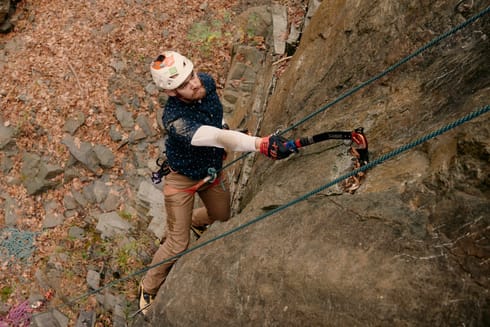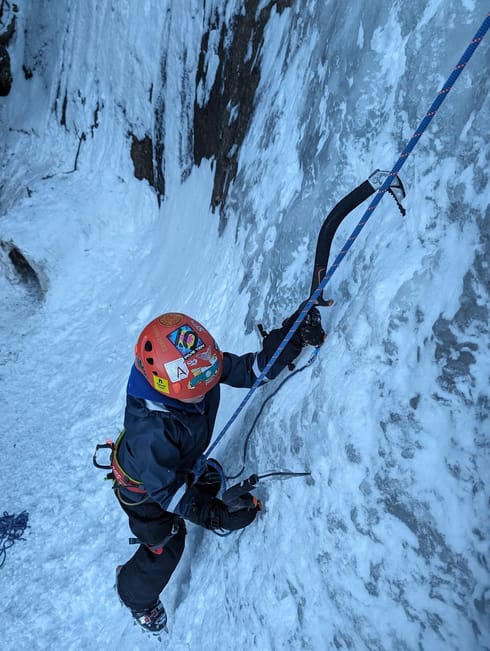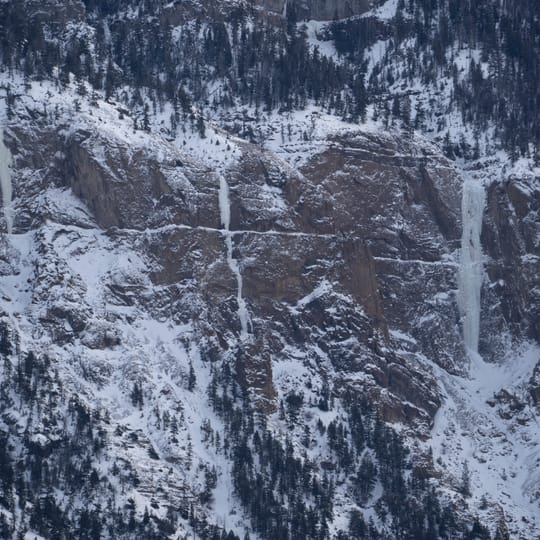
Winter Camping and Climbing in Cody
The ice climbing in the South Fork of the Shoshone outside Cody, WY, is an immense and rugged playground for intrepid ice climbers with a sense of adventure and who don’t mind a bit of suffering.
By Zach Eiten
Most ice climbers will have heard of “Cody.” Home of huge multipitches. Rugged, never-ending approaches. Massive pillars. Sandbagged grades. The best ice climbing in the lower 48, so they say. But the thing to understand for a newbie is that the ice climbing isn’t actually in Cody.
It’s in the South Fork.
The South Fork of the Shoshone River is an agricultural valley just outside of Cody. A sleepy two-lane road defines the community where people wave when they pass going the other way. Here you’ll find actual cowboys; working ranches; a one-building schoolhouse; hunters, trappers; and the occasional second home.
And eventually, once you drive past all that, you’ll be greeted by a broad, lazy river flanked on either side by craggy peaks that rise 2,000-3,000 ft. off of the valley floor. These peaks drop away sharply as they approach the valley: steep, terraced walls adorned with shimmering ribbons of vertical ice pouring down the natural drainages. The real cherry on top is that due to the valley’s low elevation, there is usually very little avalanche hazard.
As someone who has visited several times and spent over a month camping in the South Fork, let me help break it down for my fellow visiting dirtbag who wants the honest beta beyond staying in town and commuting to climb.
Quick Facts
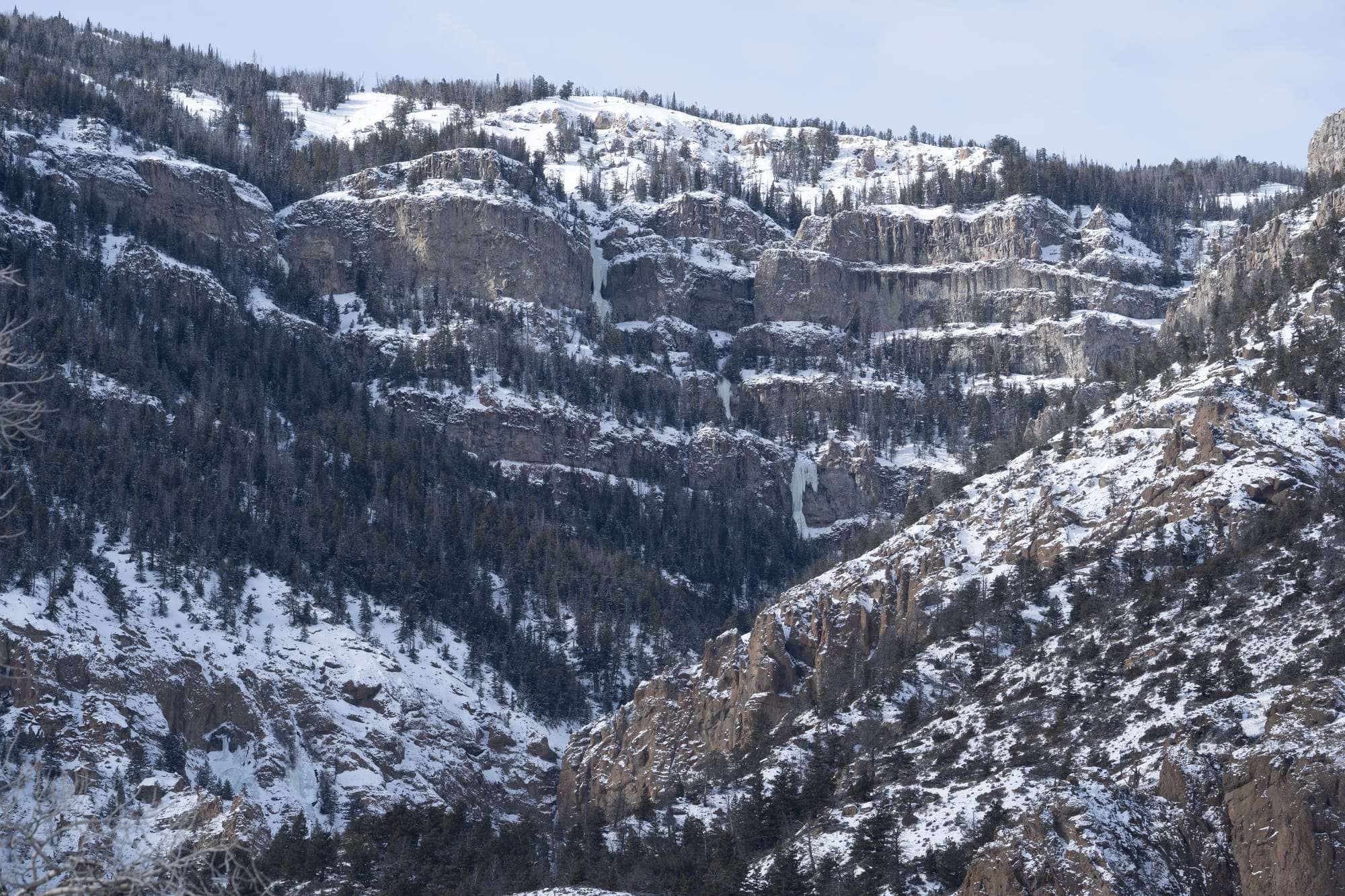
- Season: December to March is the traditional season, although you can definitely climb both before and after this window. The further you get from the winter solstice, the more sun the campground gets.
- How to get there: Cody has a small regional airport (small meaning about one gate), but most climbers will want to drive themselves, especially if planning on camping. In good weather, it’s about a 7 hour drive from Denver or Salt Lake to the town, and an additional 1 hour or so to the climbing in the South Fork.
- What’s the character: Cody is characterized by burly approaches, few crowds (for now), few fixed anchors, and long multi-pitch ice climbs. The multi-pitches form in drainages, meaning you usually get a pitch or two of vertical ice, followed by some horizontal hiking, and then eventually another steep pitch. Many of the longer climbs require soloing and down-soloing steps of WI2 or WI3 as you traverse the drainages.
- Beginner-friendly? Cody is a destination for experienced ice climbers. It is not a good place for beginners, especially those without a guide or rope-gun. Top-rope options are almost non-existent.
- Car needed? A car is mandatory for climbing in the South Fork. Good tires and AWD/4WD are highly recommended as well. If you are staying in town, understand that it’s a ~1 hour drive each way to the climbing, and this road is often very icy.
- Places to stay:
- Deer Creek Campground (closest, free)
- Double Diamond Ranch (hostel, closest services to climbing)
- Motels or AirBNB in town (long drive, but access to restaurants)
- Local ethics: The attitudes in Cody are old-school. You won’t find a busy Facebook group, nor will you find the locals too willing to give out their secrets. Do not expect to rely on fixed anchors for descent, even on heavily-trafficked classic lines. This is an alpine testing ground and an alpine feel should be expected. Bring double ropes.
- Showstoppers:
- Popular moderate multipitch climbs include High on Boulder /Moonrise (WI4/5), Mean Green (WI4), Broken Hearts (First 4 pitches WI3, upper pitches WI5/6), and the aesthetic Sendero Illuminoso (WI4).
- Some well-known testpieces include Ovisight (WI6), Carotid Artery (M7 WI6), Joy After Pain (WI5/5+)
- There is A LOT of good climbing in the valley beyond the well-known stuff.
- Social Scene: The campground is your best bet to meet fellow climbers. There is no climber bar or hangout in town. Most folks come to Cody with a partner and a plan.
Camping in the South Fork
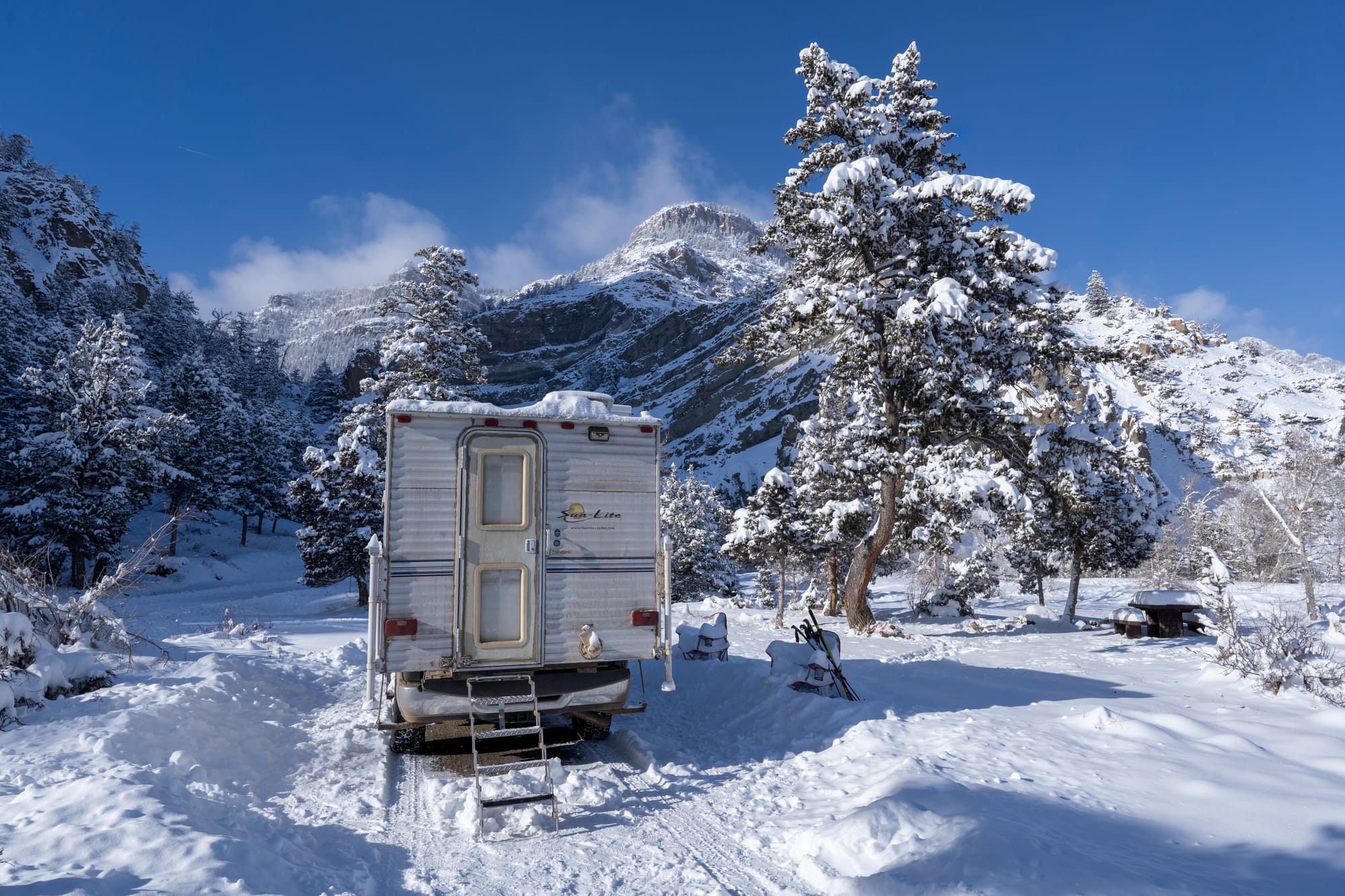
The town of Cody offers plenty of affordable motel-style lodging, as well as some nice AirBNBs, but full-time climbers will quickly realize the drive to and from town consumes significant gas and can be pretty hairy. Although you must be equipped for winter camping, staying in the South Fork is a very reasonable option.
There are roughly three ways to camp in the South Fork: the Deer Creek campground, the Double Diamond X Ranch, and a handful of pullouts. I have used all three options, with the most time spent at the campground. Regardless, many people either don’t know about the campground or may be intimidated by camping in the middle of winter in Wyoming, which I will hopefully shed some light onto.
Double Diamond X Ranch
If you want a legit bed, shower, etc., then the Double Diamond X Ranch is a great option. The folks over there are very nice and for a fee you can stay in the bunkhouse on their property that they put the ranch hands in over the summer. You have to bring your own bedding and cooking supplies. Current rates (March 2025) are $41/person/night or $150/night for one half of the property (six beds).
One thing to note: the owners of the DDX don’t allow non-paying climbers to come onto the property to hang out. In case you are planning on meeting up with friends after climbing, you’ll need to rendezvous elsewhere.
As of March 2025, American Alpine Club members are entitled to a 10% discount with proof of membership.
Pullout Camping
There are a handful of pullouts here and there which climbers with sleeping setups in their vehicles will sometimes use. This option is only ideal for the short term — a night or two at most.
In regards to these, just make sure you are not encroaching on the properties of the various ranches in the valley. The property lines frequently cross the road in areas. An accurate landowner map is useful to make sure you are not on private property (I recommend the apps Gaia GPS and/or OnX Hunt). This being Wyoming, these things matter, and locals will pay attention. Respecting private property is of utmost importance to maintain access to the area and avoid an unpleasant confrontation.
I won’t give you any more detailed beta than this — but use your common sense and act with respect for the residents of the valley.
BLM Deer Creek Campground
Now if you want free camping in a legit spot, then the Bureau of Land Management-administered Deer Creek campground is the way to go. For reference, I live in a truck camper with my wife and dog, but we shared the campground with many tent campers, and it was very doable no matter the setup.
The BLM campground is right off the South Fork road—impossible to miss. It consists of six campsites, each with a short pull through driveway for vehicles; a spot for a tent to two; a fire pit; a table; and a bear box. There is a single pit toilet which the BLM restocks year round (Score!). The campground is free (as of spring 2025), however, a $10/night fee has been proposed. Hopefully it remains free and donation based as before.
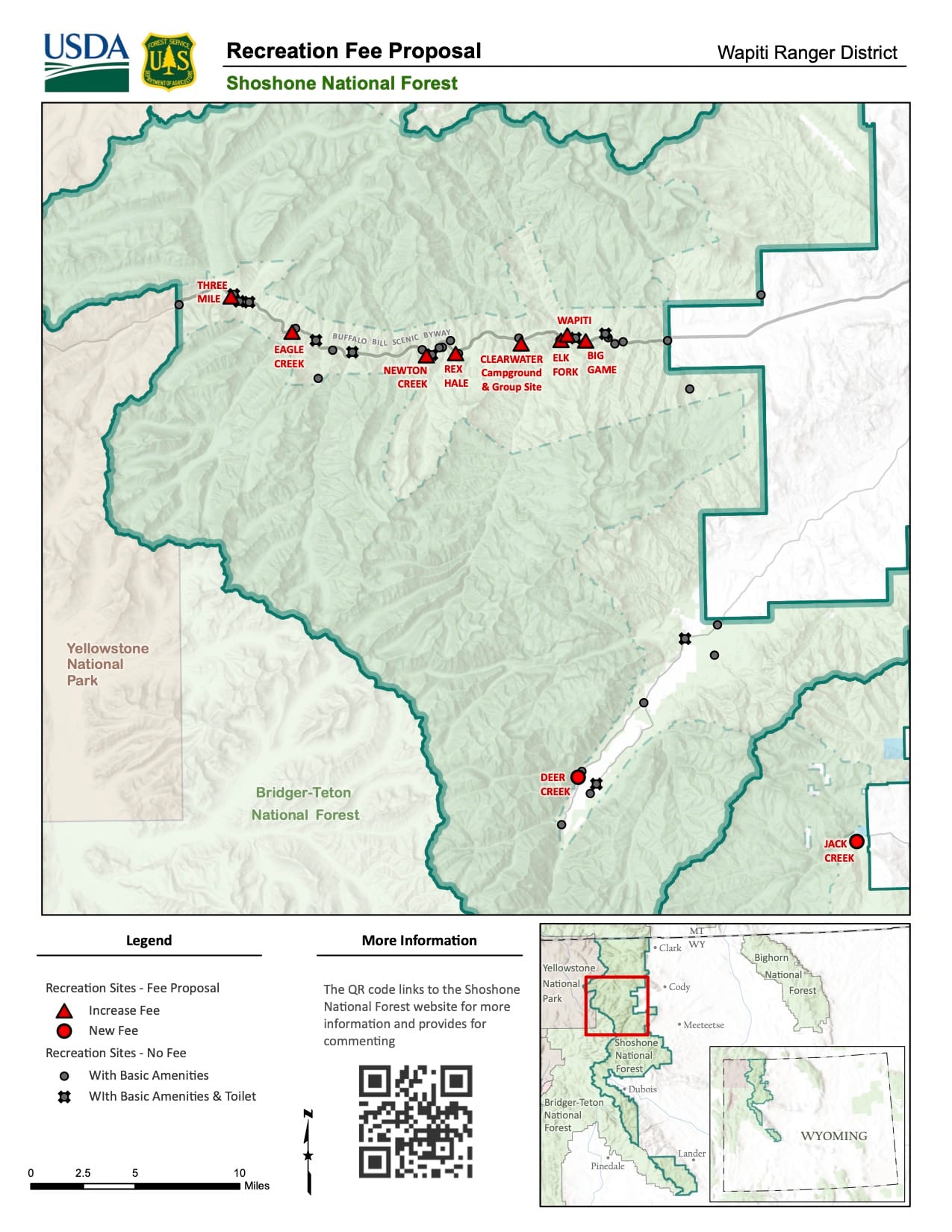
The valley of the South Fork is relatively broad, so the campground gets sun for a large chunk of the day. This allows everything to warm up and dry out each day, as long as there is sun. We generally had enough daylight to maintain the solar batteries in our camper. Due to the dry nature of the valley and the amount of time that the sun hits the camp, even if it does snow, I found that it generally doesn’t last too long.
Drying Ice Climbing Gear while Camping
With some determination you can easily dry out all of your gear each day after climbing. There are fire pits, but using the power of the sun is your best option.
The pro-tip here is to bring a shovel and an ice-scraper to clear areas around your car/tent, and to clear off the table. If you do this, then you will only need minimal sun to keep areas you want usable and free of snow. I have a flathead shovel that I put in my truck bed alongside the camper and anytime it snowed I would clear a few feet around the car, the table (for drying our gear), and a walkway to the bathroom, and the snow was a non-issue.
Vibes and Availability
The best part about the campground is that it is very quiet and therefore very intimate. In 2024 when I was last there, we spent more time chatting and hanging out with fellow climbers and campers than any other climbing area that I can think of. Literally as I write this, I am making plans to go ski in Alaska with the friendly Alaskans that camped next to us in the South Fork for about two weeks! Playing endless rounds of Farkle in our camper with the Alaskans and a series of crews from SLC was a highlight of my year.
As I said, there are about six first-come-first-served campsites, and they generally don’t fill up, except perhaps on weekends. Even if they do, you can rest assured that someone will probably share with you as long as you ask nicely. If you are unwilling to do this, then move on or expect a much different experience than I have described above.
Climbing in the South Fork
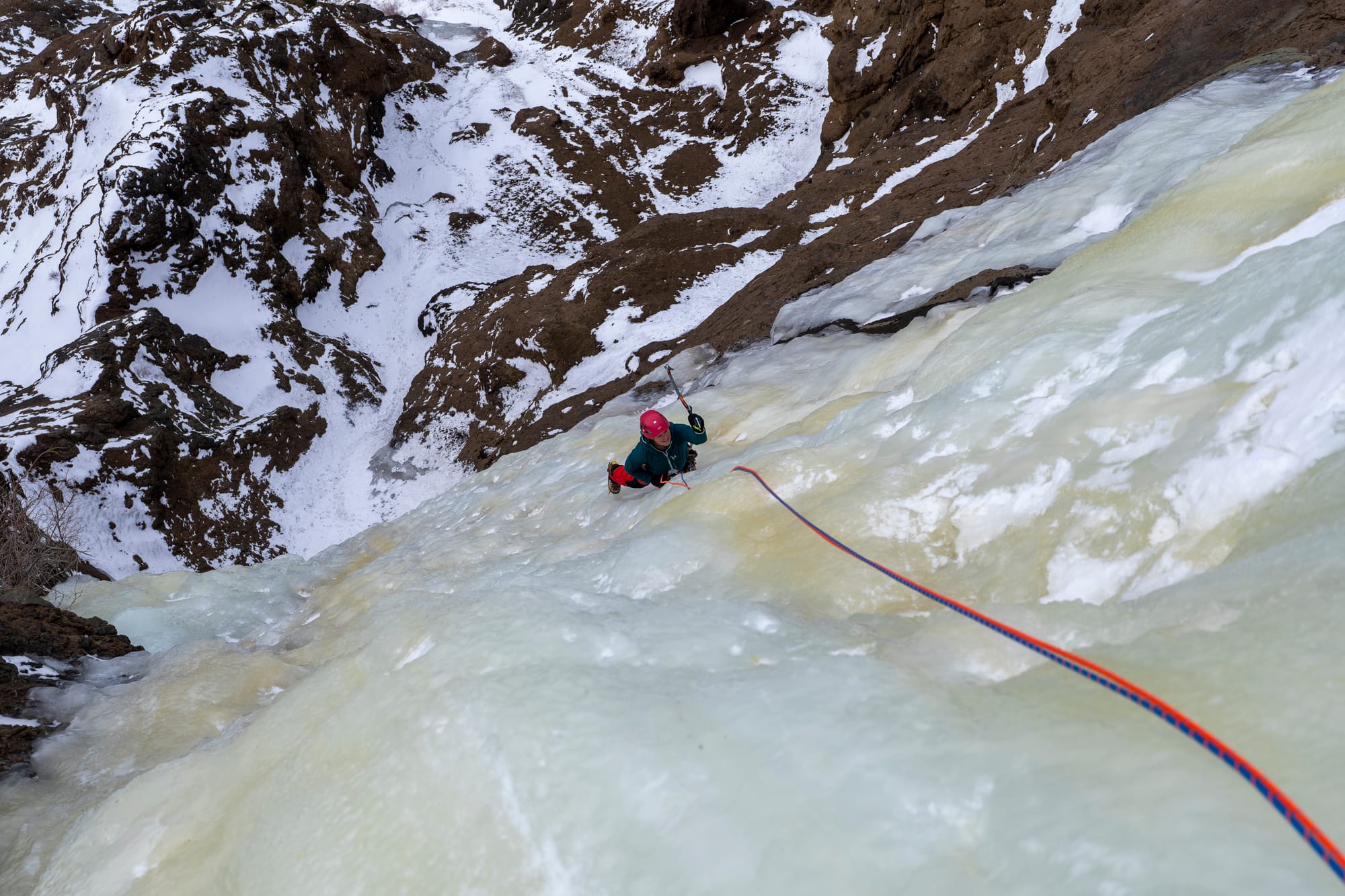
Seeing as exploration and adventure are a large part of the experience and local ethic in the South Fork, I won’t spoil the specifics of it for you here. However, there are a few things you can expect, including your fair share of bushwhacking, some interesting and frigid river crossings, miles of ice, and tons of wildlife.
Bushwhacking
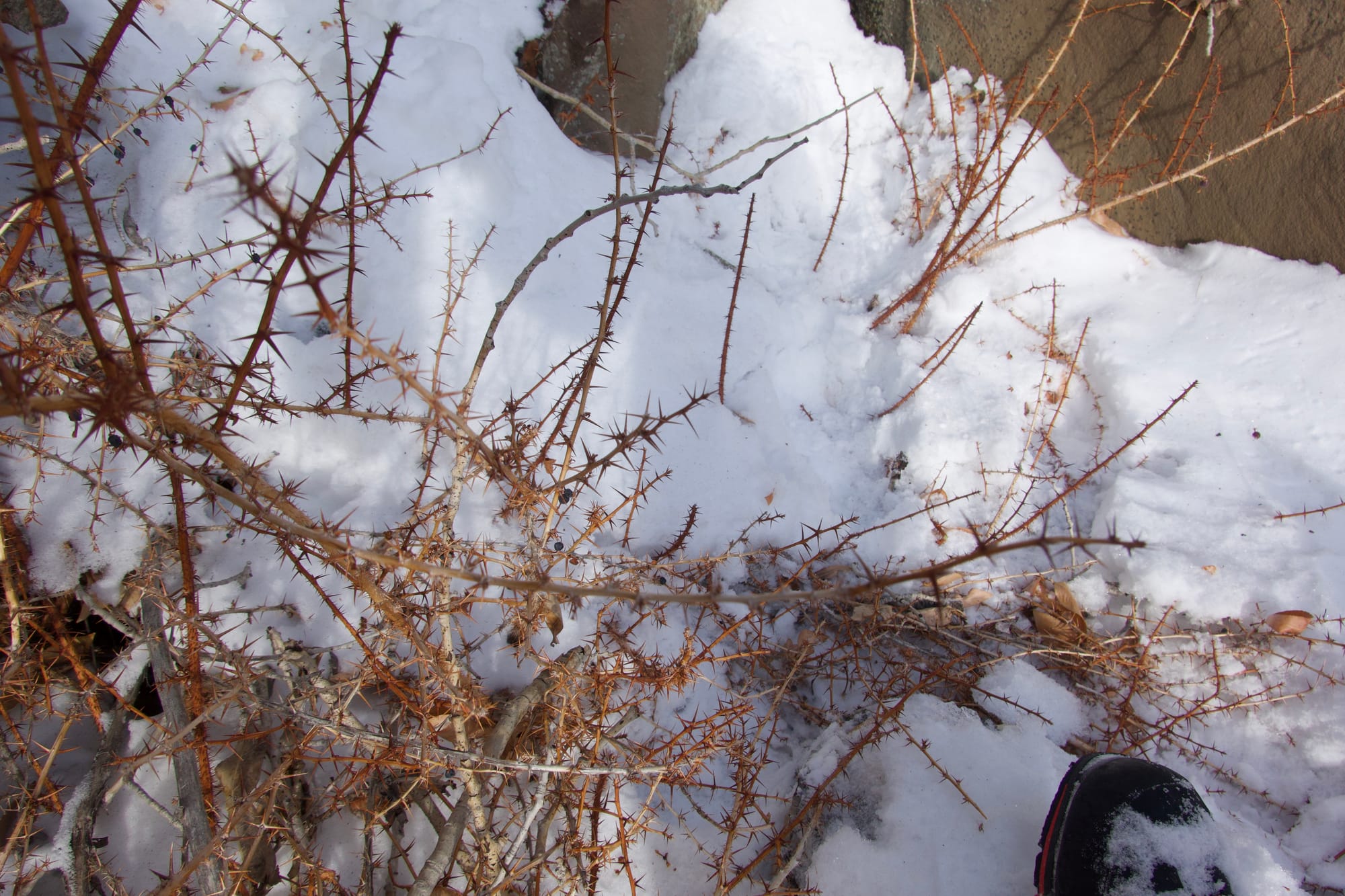
Although visitation to the area is steadily increasing, Cody remains pretty quiet relative to other ice climbing venues. There are few established trails, and you can reasonably expect that you will be bushwhacking up or down some heinous BS each time it snows and covers up previous signs of activity. Your navigation game has to be on point in Cody. Anyone who has spent significant time climbing in this valley has a story or two of getting hopelessly lost in the brush.
River Crossings

Another fun aspect of Cody is that many climbs require crossing the Shoshone river on foot. Unless you are there in the dead center of the season and the river is completely frozen over, you will either have to build yourself a bridge out of logs, or take the plunge and ford the river. I like to call the latter the “South Fork baptism,” and encourage everyone to try it once! Luckily, the river is pretty low-flow in winter and not too deep.
It helps to bring some extra lightweight shoes like Crocs or old approach shoes to cross the river quickly. You can easily go barefoot, but it’s nice to have some extra shoes you can get wet because it is not uncommon to have to cross ice, ford a section of river, climb back up onto the ice, ford another braid in the river, and repeat this process a few times until across. A spare pair of socks and a microfiber towel see you across in luxury.
Trekking poles are useful both for bushwhacking and crossing log bridges on the river.
Wildlife

The South Fork is home to a lot of animals - both domestic and wild.
Deer
Be very cautious driving in and around the South Fork. My buddy calls the South Fork “infested” with deer, which I thought was an exaggeration until I visited for the first time. There are deer everywhere, and they seem to have no regard for their lives. With deceptively-tall brush along the sides of the road, be sure to drive slowly because they will inevitably pop up out of nowhere, right in front of you.
Bighorn Sheep
The South Fork of the Shoshone river is also an important bighorn sheep migration corridor, and you may see large herds of these animals. Be sure not to crowd their space, either in a vehicle or on foot - they are easily stressed and can actually be frightened to death! These sheep are very important to the local ecosystem and are sought after by hunters, so be a good steward and give them a wide berth.
Bears
Bears also live in the South Fork, potentially including Grizzlies. Bears MAY BE ACTIVE if the weather is warm, so if you are at the campground, make sure to place all scented items in the provided bear boxes. Bear spray is usually not needed in winter, but is worth a thought in shoulder season.
Others
If you keep an eye on the ground, many animal tracks can be spotted in the snow. For the naturalist, a scat and track identification book could be a fun addition to the pack.
Route Selection, Conditions, and Getting Around
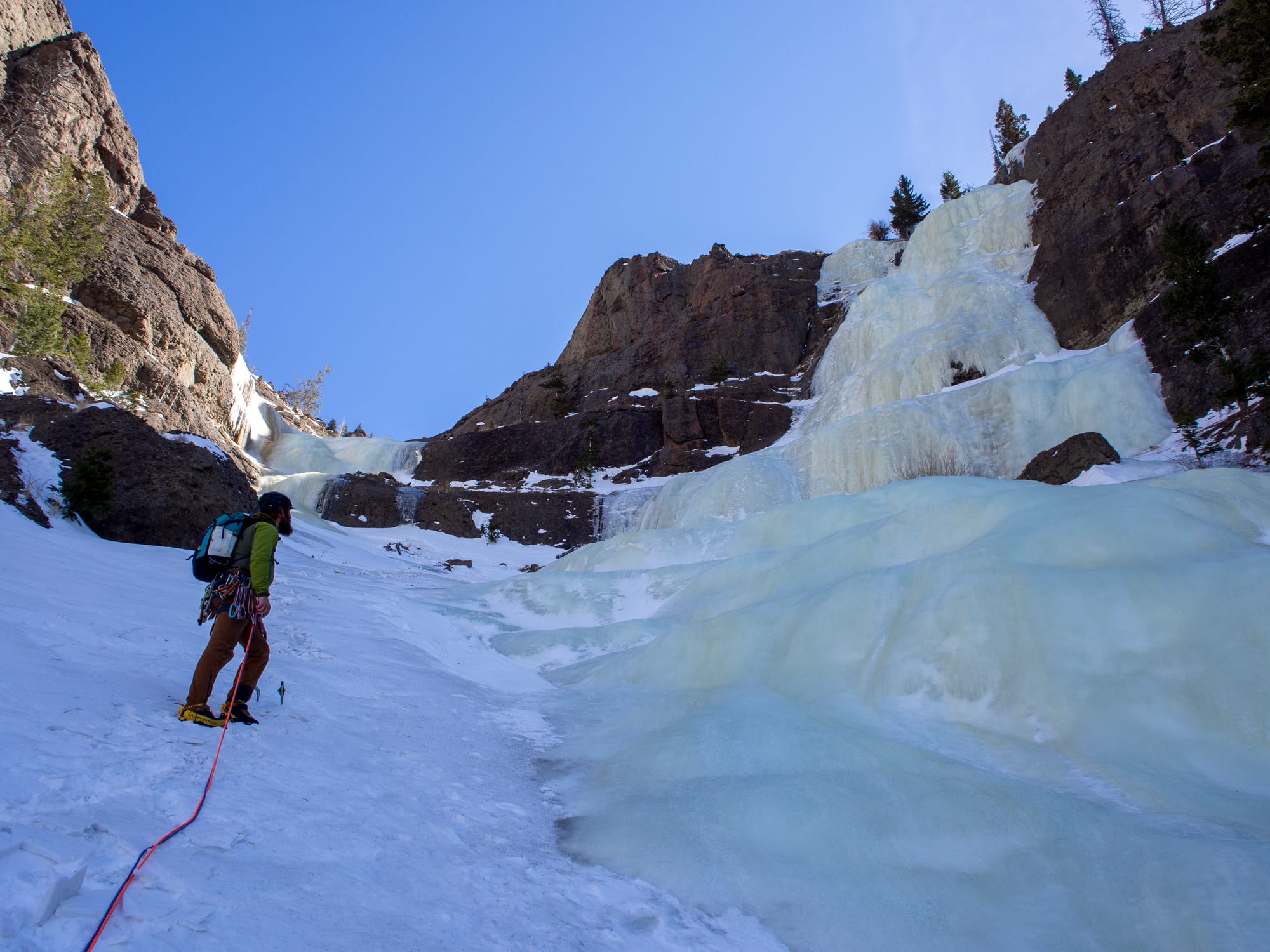
For route beta, Mountain Project works well for the well-travelled routes.
Cody Ice Climbing Guidebook
Winter Dance: Select Ice Climbs in Southern Montana and Northern Wyoming by Joe Josephson is the best guide book for the area, although it’s now a real pain in the ass to find. If you are an American Alpine Club member, the AAC Library is a great resource to use: they will mail you a copy for your trip, you just pay return postage. The Park County Library in Cody also has a copy.
Coldfear
Aaron Mulkey (@coldfear) is the most prominent South Fork climber, and the most open-handed with beta. Keep an eye out for his Ford Bronco around the valley. Aaron’s Instagram page is useful to follow because he posts frequent conditions reports from the area. He also has a website (coldfear.com) where he reports on which climbs are in or not throughout the season. Aaron is working on a much-anticipated new guidebook for the South Fork and surrounding areas. Release date: someday…
What to Climb?
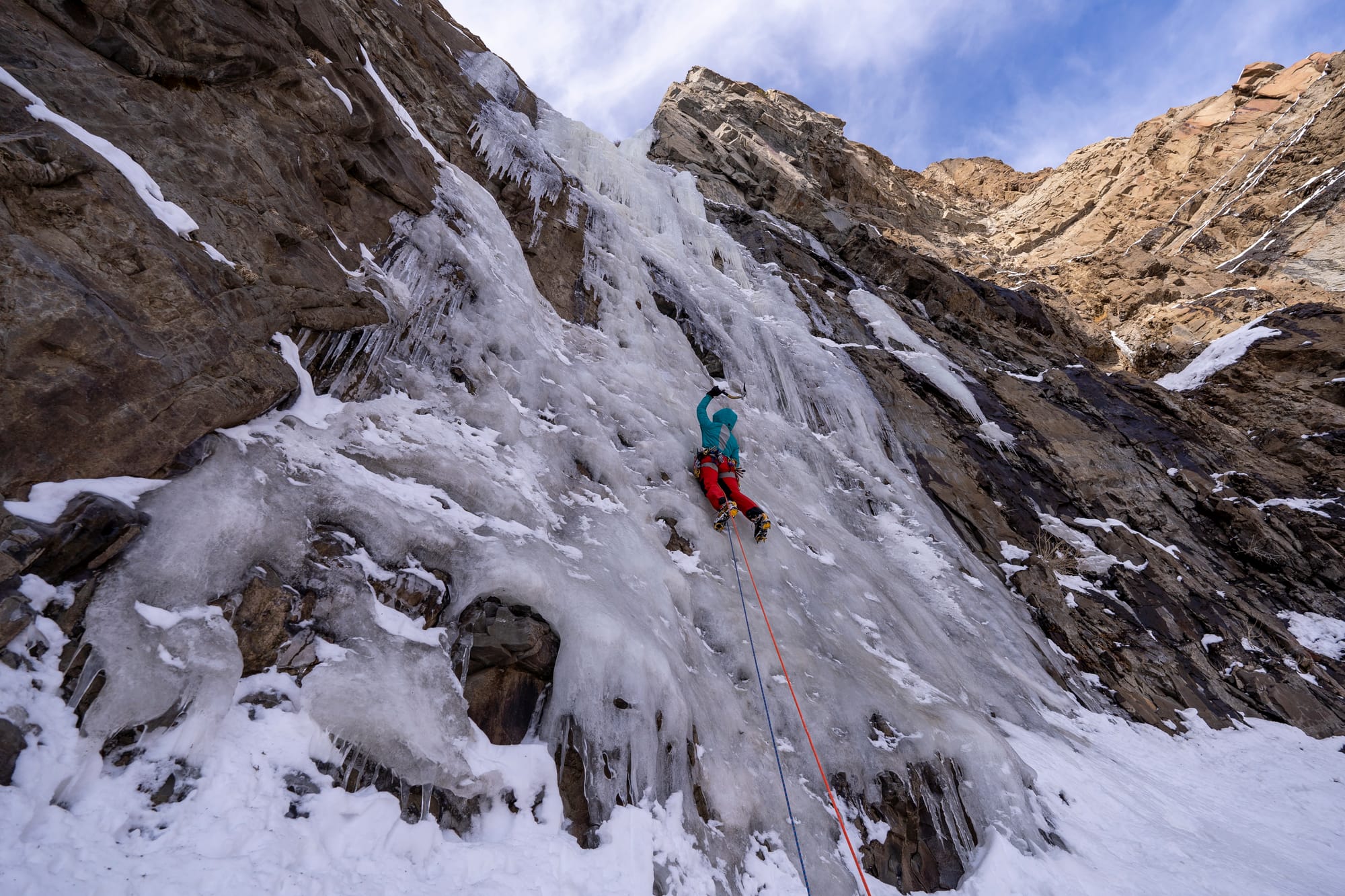
It's a good idea to understand which side of the valley your climb is on - climbs on the sunny North side can get toasted by the sun, becoming dangerous or even melting completely during warm periods. Climbs on the South side are much more reliable.
When it comes to the routes specifically, if you are newer to climbing in Cody, be sure to sprinkle in some less-travelled climbs into your itinerary. Most people concentrate around the well-known mega classics (High on Boulder, Mean Green, etc.) which means dealing with more people and more-trafficked ice. I found the exploratory climbs to be just as good as the mega-classics for their alpine feel and the adventure involved. Pick a piece of ice and find your way there!
Playing Nice With Others
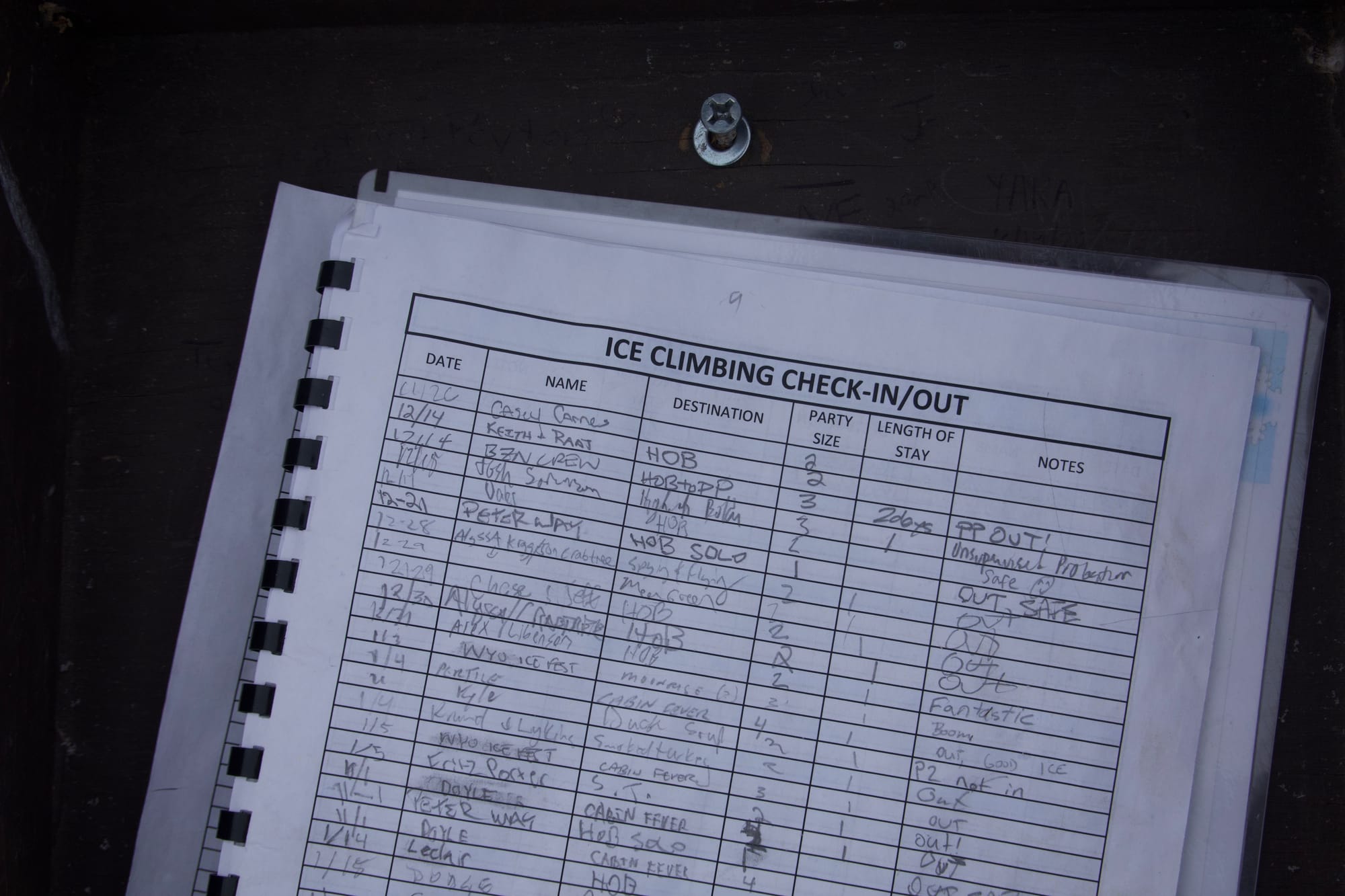
The climbs in Cody are very long, generally straight, and require rappelling the line of ascent. Icefall and rockfall are serious hazards, and climbing behind other parties can be a dangerous proposition. It is very useful for everyone to make an effort to relay where they are climbing to other parties.
There is a Climber’s Register at the Cabin Creek Trailhead (the end of the road) where a good chunk of the climbs are accessed from. There is also a register next to the pit toilet in the campground. It is extremely helpful to sign in what climb you are doing that day.
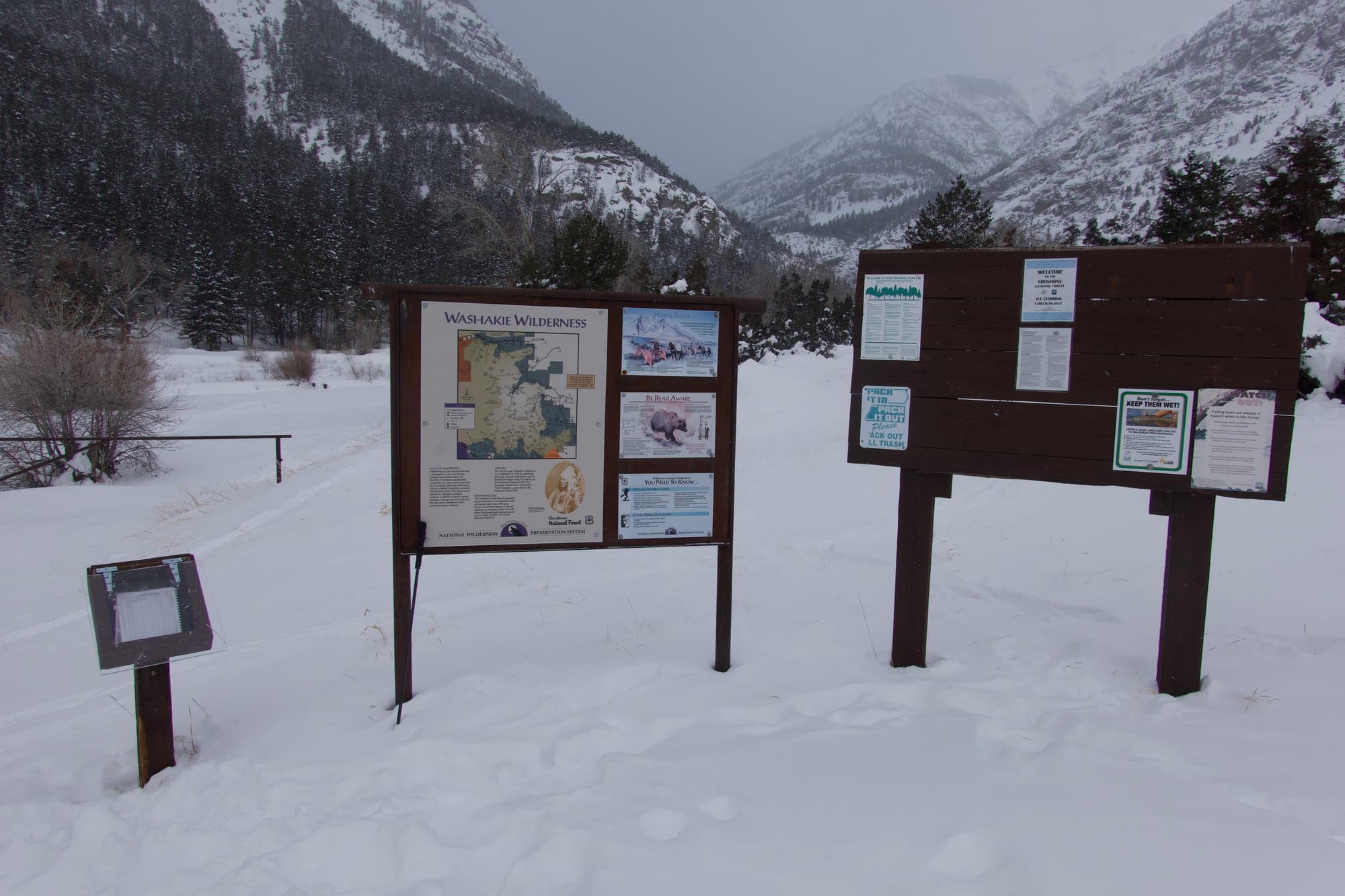
This way climbers can see where the parties that have already left the trailhead are heading and can change their intended destination if need be. It’s a win for everyone so climbers won't do long approaches to bunch up in the same spot. At the other trailheads, it is useful to write what you’re climbing in the grime on the back window of your car.
If you do end up climbing behind another party, understand that you are putting yourself at risk, and the party above is not responsible for protecting you.
Loose Rock - A.K.A. the “Cody Choss”
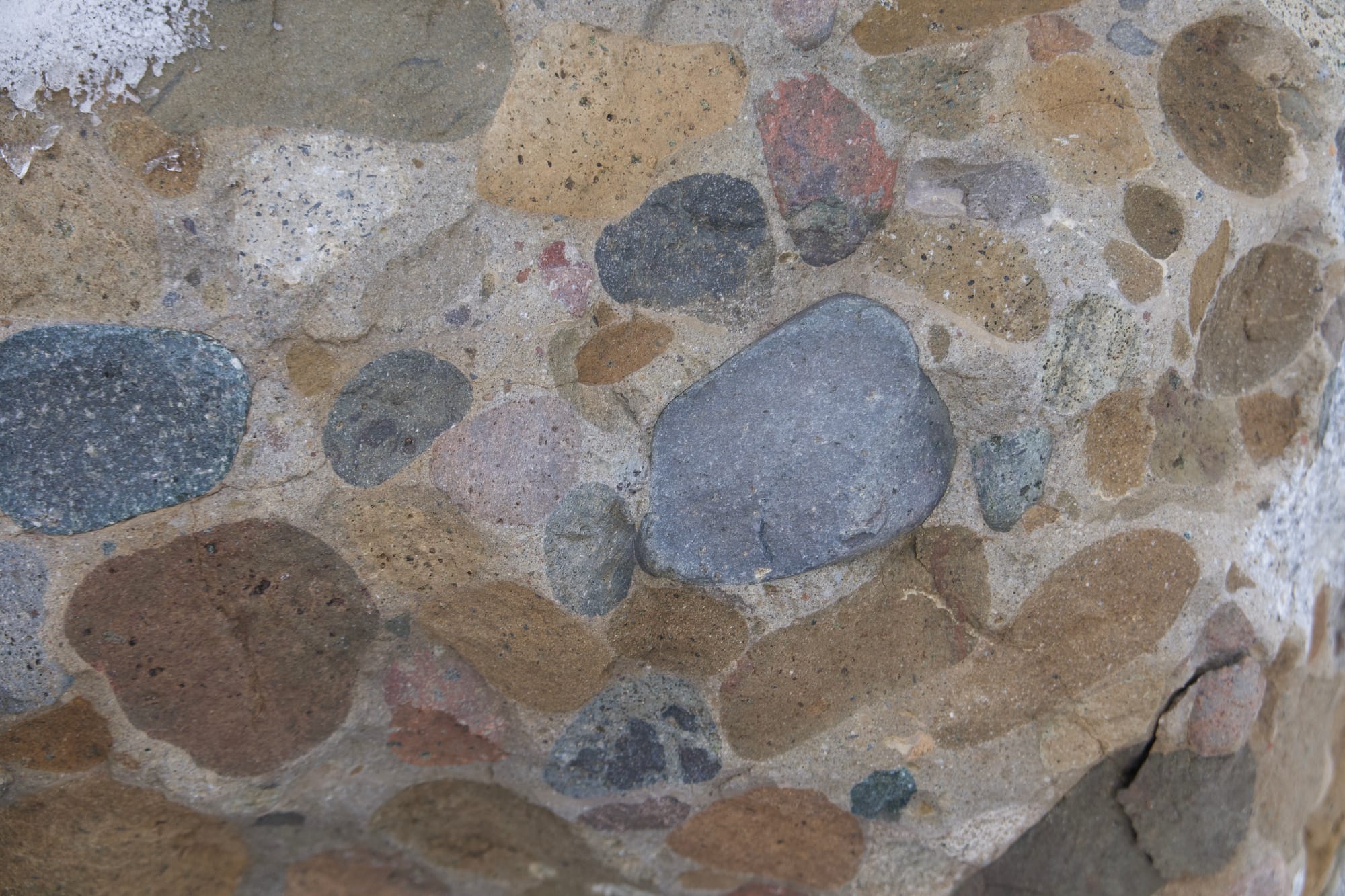
The rock in Cody is complete and utter choss. It’s more akin to mud, and in spring and summer, it IS mud. Bolts can appear and disappear because the rock just falls off. Although some mixed routes may call for it, traditional rock protection won’t bring you many happy feelings here.
I highly recommend using V-threads and trying to rappel down the center of the ice. If you’re climbing in Cody, making a V-thread shouldn’t intimidate you. Stay away from the rock on either side of the ice climbs if at all possible! Many descents involve rappelling off of a tree on the side of the drainage — try your best to keep the rope from running over the rock if you can, and be aware of people below. A cautionary tale:
While rappelling Mean Green (WI4) my partner headed down first and made the mistake of rappelling down the edge of the ice. He reached a ledge and started making a V-thread for the next rappel below, when suddenly — WHAM! A baseball sized rock had somehow become dislodged and fell 100 feet, ricocheted off the ice, and hit my buddy directly in the eye. Thankfully, his sunglasses deflected most of the blow, and he managed to escape with only about a dozen stitches. Now I always try to rappel plumb-center down the routes in Cody to avoid the rock.
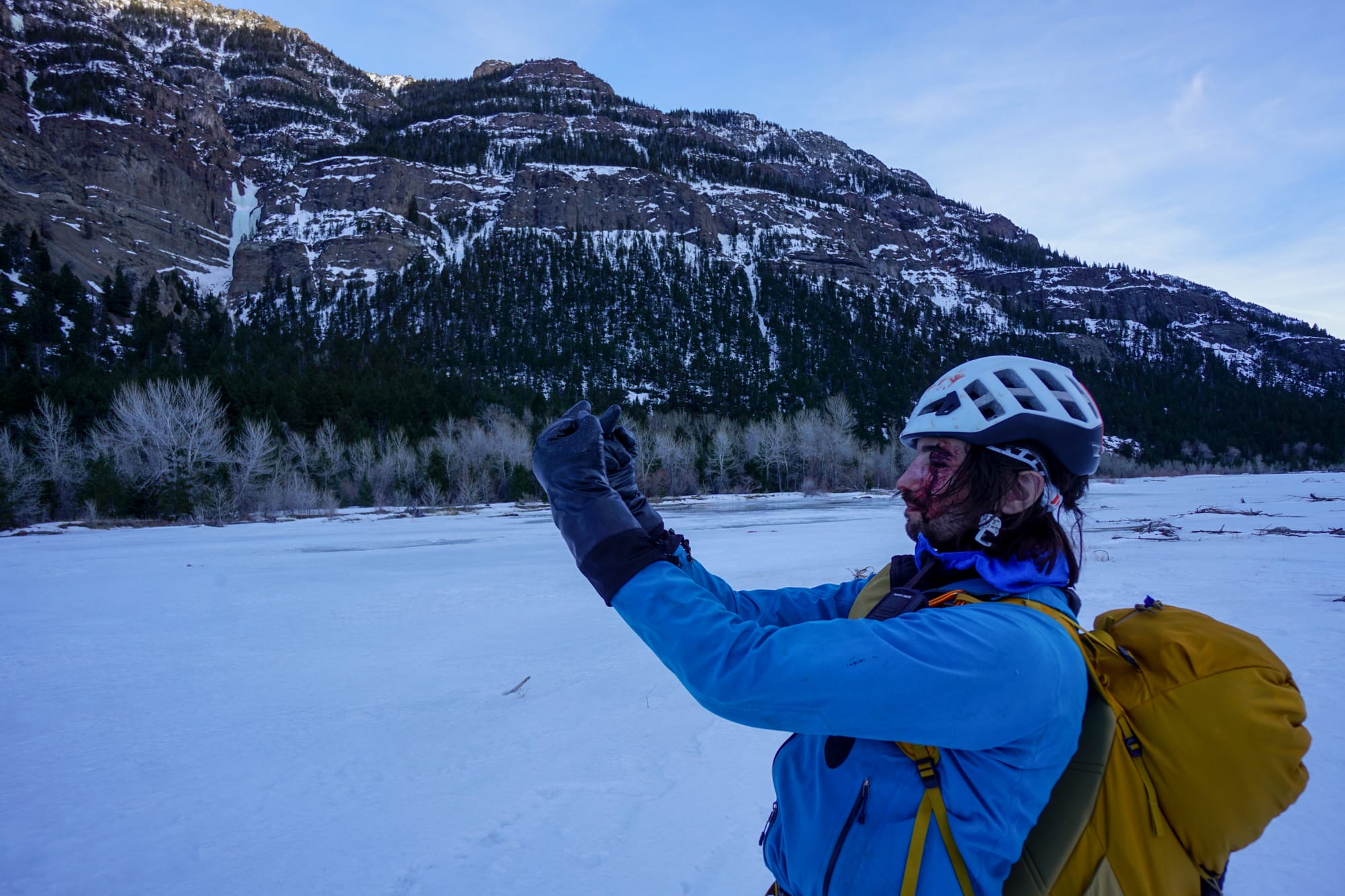
Resources for Dirtbags
As someone living full time in a truck camper traveling around climbing I understand how challenging it can be to find good no-nonsense beta on local resources like where to sleep, get water, and so on. So here is the down low on all things for the dirtbag in and around Cody along with some important considerations while in the area.
Water
Water fill ups can be hard to find around Cody, but the Maverick gas station on 17th St. has been reliable each time I visit. They have a water spigot on the north side of the building that you can place a 7 gal blue jug underneath or attach a hose to. If the weather is exceptionally cold keep in mind that spigots might freeze.
Showers
You can find showers for a small fee at the local rec center (Paul Stock Aquatic and Recreation Center), and for a bit more $$$ they have a hot tub and pool, which I highly recommend if you’re in town for a rest day to de-thaw from camping.
Propane
Moving onto propane, we use 20-pound propane tanks for our camping setup and found Walmart to be the best and cheapest place to replace them. When I say cheap, I mean cheapest I have ever seen on the road. As of 2024, a propane tank exchange at Walmart in Cody was $15! Walmart also has the cheapest groceries in town, with the competition being Albertson’s. Those are the only two options for grocery.
Gear
In terms of gear, Sunlight Sports on Sheridan Avenue has the best selection of climbing gear in town. They do not do rentals. The hunting/ranch supply stores in town also carry quality goods for an outdoorsman, although the brands may be other than what you are familiar with. But overall, you should bring what you need and not rely on picking it up in town.
Working
If you are looking to spend a day on the computer, there are a couple places to do it in town. Cell service in the South Fork is extremely limited and should not be relied on for much.
The Beta coffeeshop has a cozy vibe, good food, and a copy of the Winter Dance guidebook in their bookcase. They are only open until 2 on most days. There are a couple other coffee shops in town, including a Starbucks. Hours and vibes may vary.
The Park County Library, in addition to being a stellar library in its own right, offers a free and quiet place to work.
Conclusion

Hopefully I didn’t miss anything to cover your bases when it comes to Cody ice. Most important is to have fun and be safe. Cody is very unique since you’ll be in sight of a road, but the climbing, terrain, and experience lends itself more towards a full on alpine experience, so plan accordingly. Be respectful to the land, the animals, the ranchers, and the other climbers and you will have an amazing time climbing endless ice in one of the last vestiges of the “wild west.”
About the Author
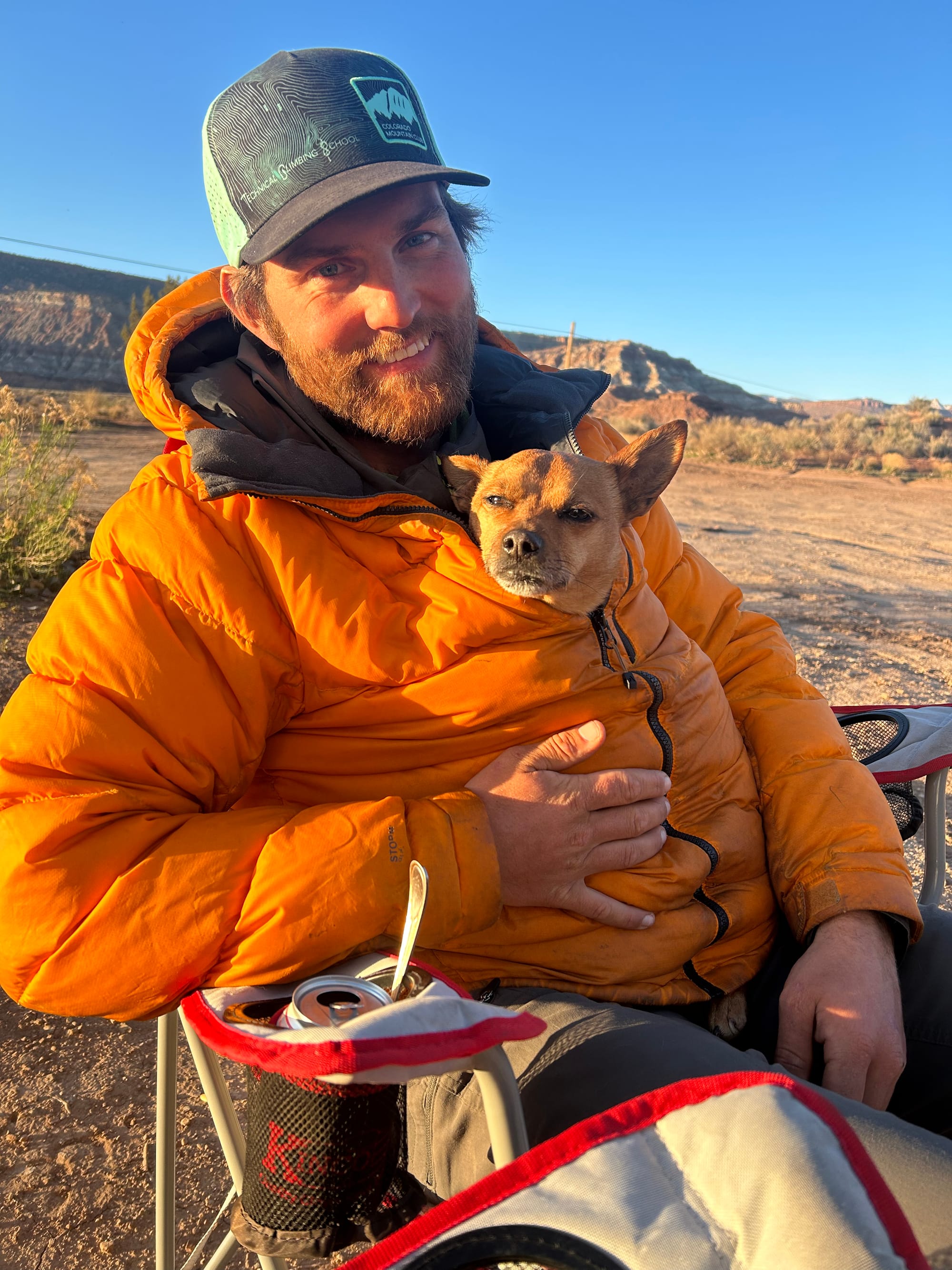
Zach is an aspiring alpinist, ski mountaineer, climber, and photographer. Zach is currently living on the road climbing and skiing with his wife, Emma, and their adventure dog, Zeke. You can find him wherever his truck camper is parked somewhere in the Western USA or Canada. When he isn’t on the road, Zach works as a biologist and is an active volunteer in the Colorado Mountain Club.

